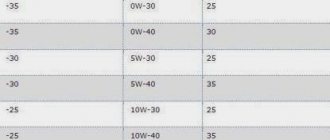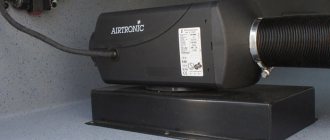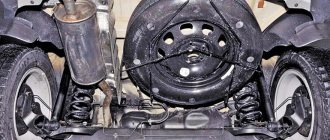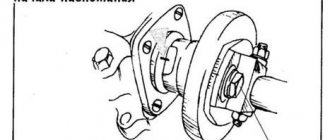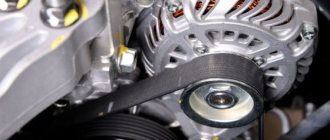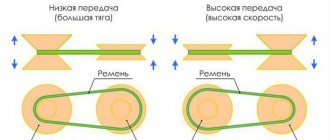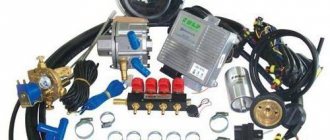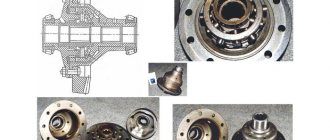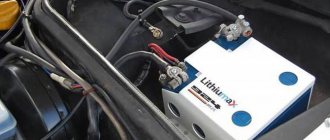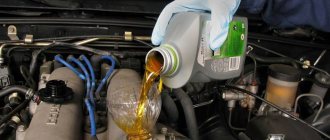VAZ cylinder block: 2103, 2106, 21213, 21214, 2123, 2130.
Cylinder block VAZ 2103 | Cylinder block VAZ 2106 |
Block designs for VAZ engines with longitudinal placement in the engine compartment are united by one common feature - an inter-cylinder distance of 95.00 mm.
VAZ cylinder block
are made by casting using special high-strength cast iron. The block has four working cylinders. The cylinders are located on the same line, in one row. Engines of this design are called single-row. The surface of the cylinders is formed by boring the block body and followed by special grinding - honing. The processed inner surface of the cylinder is called the cylinder mirror.
Based on the results of final processing, depending on the manufacturing error, each cylinder is assigned one of five classes: A, B, C, D, E. The size difference between classes is 0.01 mm. On the lower plane of the block, opposite each cylinder, a cylinder class marking is applied with a stamp.
The block has internal cavities that form the so-called cooling jacket. When the engine is running, coolant circulates in the jacket, ensuring heat removal. With this design, the diameter of the cylinders and the distance between the cylinders make it possible to have cooling jacket cavities between adjacent cylinders. In its development, the design of the “classic” block underwent changes mainly due to an increase in the diameter of the cylinders. The diameter of 82.00 mm is the limit to ensure strength characteristics while maintaining jacket cavities between the cylinders.
To install the crankshaft, the design provides five supports. The supports serve as the basis for the main bearings (main bearings). Fixation of the crankshaft and main bearings is ensured by the main bearing caps. To ensure accuracy, the main bearing caps are bored together with the cylinder block.
During assembly, each cover must be installed on the support with which it was processed together. To fulfill these requirements, each cover has special markings in the form of marks. They allow you to determine whether the cover corresponds to one or another support. The supports are numbered from the front wall of the block. In addition, the technological number of the cylinder block with which they were processed together is stamped on the covers. The same number is stamped on the bottom surface of the block in the plane of the connector. Additional insurance against incorrect installation is provided by holes in the main bearing cap. Their non-symmetrical arrangement will prevent incorrect installation. The covers are attached to the supports with special self-locking bolts.
On the rear, fifth, support there are special recesses designed for installing thrust half-rings. Half rings allow you to limit the axial displacement of the crankshaft. The maximum permissible value of the axial clearance is considered to be 0.35 mm. If the gap increases, it is necessary to install new half rings. If after this the gap still remains greater than permissible, installation of repair half-rings with a thickness increased by 0.127 mm is required. When installing, it is necessary that the surface of the half ring, on which there are lubrication grooves, faces the side of the crankshaft thrust surfaces.
When assembling the engine, special attention should be paid to the correct installation of the liners. Liners with an internal circular groove are placed in the cylinder block supports “1”, “2”, “4”, “5”. In the main bearing caps, liners without an internal groove are placed. The inserts for the middle, third, support are different from the rest.
Cylinder volume
BMW headquarters ("4 cylinder"[1]) in Munich.
For an inclined cylinder there are two formulas:
- The volume is equal to the length of the generatrix multiplied by the cross-sectional area of the cylinder by a plane perpendicular to the generatrix. V = S ⊥ l {\displaystyle V=S_{\perp }l} ,
- The volume is equal to the area of the base multiplied by the height (the distance between the planes in which the bases lie): V = S h = S l sin φ {\displaystyle V=Sh=Sl\sin {\varphi }} ,
where l {\displaystyle l} is the length of the generatrix, and φ {\displaystyle \varphi } is the angle between the generatrix and the plane of the base.
For a straight cylinder h = l {\displaystyle h=l} . For a right cylinder sin φ = 1 {\displaystyle \sin {\varphi }=1} , l = h {\displaystyle l=h} and S ⊥ = S {\displaystyle S_{\perp }=S} , and volume equal to:
- V = S l = S h {\displaystyle V=Sl=Sh}
For a circular cylinder:
V = π R 2 h = π d 2 4 h {\displaystyle V=\pi R^{2}h=\pi {\frac {d^{2}}{4}}h} ,
where d
- diameter of the base.
The design of the engine cylinder block: simple about the complex
The upper and lower liners are made without grooves and have a wider width than the others.
In the front left part of the cylinder block, parallel to the crankshaft, two bushings are pressed coaxially to install the drive shaft of the oil pump and the ignition distributor. During operation, the gap between the surface of the roller and the bushing should not exceed 0.15mm. If the gap is exceeded or the bushings rotate in the sockets, they must be replaced.
After the bushings are pressed in, they are processed together using a special reamer to the following dimensions: 48.08+0.02mm for the front bushing and 22.00+0.02mm for the rear bushing. When replacing the front bushing, ensure that the lubrication hole of the bushing coincides with the oil channel of the block in the bushing installation socket.
Another bushing is installed in the cylinder block - the oil pump drive gears. After pressing, the internal size of the bushing is adjusted by reamer to the size - 16.02+0.02.
In the front part of the block there is a cavity in which the gas distribution mechanisms are located. The timing mechanisms are closed with a cover in which the front crankshaft oil seal is installed. On the opposite side, a rear cover with a crankshaft oil seal is attached to the block. The description fully applies to the design of VAZ cylinder blocks: 2103, 2106, 21213, 21214, 2123 and 2130
.
Starting from 2004, all cylinder blocks produced by AVTOVAZ OJSC received continuous numbering. Each block is assigned an identification code. The code consists of a set of characters. The first character, letter or number, indicates the year the part was manufactured. The remaining seven digits are the serial number of the product.
The table indicates which symbol indicates the corresponding year of manufacture.
| Code | 4 | 5 | 6 | 7 | 8 | 9 | A |
| Year of manufacture of the cylinder block | 2004 | 2005 | 2006 | 2007 | 2008 | 2009 | 2010 |
For example, cylinder block markings
“50007860” means that it was manufactured in 2005 and has a serial number of 7860.
The code for blocks: VAZ 2123, VAZ 21214, VAZ 21213 begins and ends with the symbol “*”. Therefore, the block marking for these models contains ten characters.
Initially, the marking of VAZ cylinder blocks: 2103, 2106, 21213 was applied on the platform, near the oil filter (“Zone 1”), and for blocks: VAZ 2123 and VAZ 21214 – on the tide, in the plane of the connector with the cylinder head (“Zone 2” ).
Today, almost all “classic” blocks are marked in “Zone 2”.
From JSC AVTOVAZ, only cylinder blocks not assembled (“bare”) are supplied for sale as spare parts. The blocks are treated with a special protective lubricant of a dark (almost black) color, wrapped in oiled paper and packed in a cardboard box. The box has a standard “factory” sticker with the name and serial number.
See further - “Main block sizes”.
Engine cost
Engine from D4 Toyota brought for scrap
Having decided to sell a car engine for scrap , you need to know approximately how much money it can bring you. Remember that at each collection point they will deliberately lower the price, so approach this issue carefully. It is best to check the price from several competing companies.
As mentioned above, the engine weighs from 60 to 200 kg. The mass depends on its volume and model. The average price of ferrous scrap metal in Russia is 4–9 rubles per 1 kilogram. So we have that by handing over the engine, you will enrich yourself by 240–1800 rubles. Those. Despite the fact that there is non-ferrous scrap in the engine, it will be accepted as ferrous scrap! With standard blockage – 5%.
At particularly “arrogant” scrap collection points, the percentage of blockage can be up to 30%. Those. Subtract another 30% from the calculated amount. Run from such points immediately! The fact is that the engine is treated with special protective materials. As a rule, their total weight does not exceed 2–3 kilograms, but buyers may insist on 15%–30% blockage of the total engine weight.
Agree, the amount is small, but if you approach it wisely, you can sell the engine more profitably.
Various types of cylinder block designs
For aluminum cylinder blocks, different concepts and manufacturing methods compete with each other. When defining block parameters
cylinders, the respective technical and economic advantages and disadvantages must be carefully weighed against each other.
The following chapters give an overview of the different types of cylinder block designs.
Monolithic blocks
Monolithic blocks refer to cylinder block designs that do not have wet liners or screwed-on base plates in the form of a main bearing housing - a bedplate (Fig. 1). To obtain certain surfaces or strength, monolithic blocks can, however, have corresponding casting parts in the area of the cylinder bores (gray cast iron inserts, LOKASIL®-Preforms), as well as casting parts made of gray or ductile cast iron and fiber reinforcement in the area of the main bearing bores . The latter, however, do not yet reflect the state of technology.
| Image 1 PSA 4 Zyl. (row) |
Two-piece blocks (with base plate)
With this design, the crankshaft main bearing caps are placed together in a separate support plate (Fig. 2). The base plate is threaded to the crankcase and reinforced with spheroidal graphite cast in aluminum to reduce play in the main bearings, respectively, to compensate for the greater specific thermal expansion of aluminum. In this way, extremely rigid cylinder block designs are achieved. As with monolithic cylinder blocks, castable parts can also be provided in the area of the cylinder bores.
| Image 2 Audi V8 |
Open-Deck design with individual, free-standing cylinders
With this design, the cooling jacket is open to the parting plane of the cylinder head, and the cylinders stand freely in the cylinder block (Fig. 3). The transfer of heat from the cylinders to the coolant, thanks to the flow from all sides, is uniform and advantageous. The relatively large distance between the cylinders, however, has a negative effect on the overall length of multi-cylinder engines. Thanks to the open-to-the-top, relatively simply designed coolant cavity, the use of sand cores can be eliminated during manufacturing. Therefore, cylinder blocks can be manufactured using both low-pressure casting and injection molding.
"Open-Deck" design with cast-together cylinders
The logical conclusion for reducing the structural length of cylinder blocks with free-standing cylinders is to reduce the distance between the cylinders. Due to the displacement of the cylinders, they must, however, be made in a joint casting (Fig. 4). This has a positive effect not only on the structural length of the engines, but also increases the rigidity in the upper part of the cylinders. In this way, it is possible, for example, to save 60-70 mm on the design length of a six-cylinder in-line engine. The jumper between the cylinders can be reduced by 7-9 mm. These advantages outweigh the disadvantage that during cooling the cooling jacket between the cylinders is smaller.
| Image 4 Volvo 5 Zyl. (Diesel) |
Closed-Deck Construction
With this cylinder block concept, as opposed to the "Open-Deck" design, the top of the cylinders is closed up to the water inlet holes on the cylinder head side (Fig. 1). This has a particularly positive effect on the cylinder head seal. This design is particularly advantageous if an existing cylinder block made of gray cast iron is to be converted to aluminum. Due to the comparable design (cylinder head sealing surface), the cylinder head and cylinder head seal should not undergo any changes, or only minor ones.
Compared to the OpenDeck design, the Closed-Deck design is naturally more difficult to manufacture. The reason is the closed cooling jacket and because of this the necessary sand core of the cooling jacket. Also, maintaining narrow tolerances for cylinder wall thickness becomes more difficult when using sand cores.
Cylinder block layout and characteristics
Cylinder arrangement
The layout of the block is determined by the selected arrangement of cylinders. The in-line layout is technologically the simplest, it produces a rather heavy block, but boring it is not difficult. Crankshaft options are full-support and part-support[21], installation on ball bearings or liners[22]. The block may have fluid passages between the cylinders or (less commonly, on small ones) not have them. In the latter case, size and weight are saved. In-line cylinder arrangement is the most common in large marine diesel engines, where ease of maintenance is more important than liter weight.
The V-twin engine has two block designs - with the left and right blocks offset from each other (adjacent connecting rods on the neck), or without displacement (trailer connecting rod, unequal compression ratios on the left and right blocks). Main bearings are also sliding or rolling bearings. These first two options (in-line and V-shaped) are widely used in the automotive industry. Among other requirements, it may be more difficult for multi-block engines to satisfy the condition of a fully balanced engine for fewer than 12 cylinders, while an inline 6-cylinder engine is fully balanced[23].
W-shaped and star-shaped engines[24] provide an even more compact block and short shaft, which reduces the weight of the engine block, but have less rigidity than the first two options and are difficult to repair. They were widely used before being replaced by gas turbines in hovercraft, hunting boats (border), and propeller-driven aircraft. Star-shaped ones are still used on some types of helicopters. To maintain the required level of reliability, they require a high production culture and labor-intensive maintenance/repair. The cost of such motors is quite high.
In all cases, the dimensions of the block are determined by three quantities - the cylinder diameter, the piston stroke, and the number of cylinders. The block is a complex part that experiences complex alternating loading with thermal loads, and therefore can only be calculated approximately. After manufacturing a new version of the cylinder block, it is subjected to lengthy tests on an engine stand to find and eliminate weak points in the design, including using strain gauges. The cylinder block must have sufficient (high) rigidity to avoid unacceptable ovalization of the cylinders and scuffing of the pistons. The rigidity of the crankcase is important, ensuring reliable operation without scuffing the frame (main) bearings, as well as sufficient tempering before boring the beds to avoid their misalignment when the block warps.
The diameter and number of cylinders are either determined by the customer (continuity of design, boosting and finishing), or are calculated based on the results of thermal calculations, and are specified during the finishing process. Typically, during engine tests, weak points in the cylinder block are identified and eliminated. To increase the rigidity of the cylinder block assembled with the crankcase, the crater connector axis is made below the shaft axis; in some cases, the frame design of bearings is used even on automobile engines (Mitsubishi Mini Cab, 0.8L engine).
The following block surfaces are processed most cleanly and accurately: main bearing beds, the hole for the camshaft (or camshaft bushings), the seating surfaces of the liners (if any), the surface of the cylinders, the plane or planes mating with the block heads. The cleanliness and evenness of these surfaces is of great importance during assembly; even a small stuck piece of the gasket (rust, dent, crack) can lead to a breakthrough of oil, antifreeze or gases in this place, ruining the mechanic’s long work. Therefore, the planes are inspected and cleaned especially carefully, and the beds and bushings are checked with a bore gauge for size and out-of-roundness (the yokes must be completely tightened). If the planes are damaged, they most often need to be ground [25], and during assembly it will be necessary to take into account the change in size (for example, an increase in the protrusion of the piston) and take the necessary measures (for example, trim the pistons).
Cooling type
The main options are water and air cooling[26]. Oil is used for some specially designed engines with increased efficiency that run on vegetable oils. Water cooling (antifreeze) is used most often, allowing greater freedom in the location of the hot air outlet (including its use for heating the cabin in winter). Transport engines on cars moving at high speeds easily dissipate heat in the radiator using the oncoming air flow. Since with an increase in the power delivered by the engine, the speed of air flow to the radiator also increases, these characteristics are consistent.
Air cooling requires finning of the cylinders, which in such engines are almost always done separately. The advantage is mechanical simplicity and weight reduction, the engine quickly reaches operating thermal conditions. However, the task of maintaining optimal thermal conditions over a wide range of loads and incoming air temperatures becomes more complicated. In addition, such an engine is noisier (“ringing”), since combustion noise through the thin walls of the liner transmits vibrations to the high cooling fins. Therefore, this cooling option is no longer popular in cars, but is found in stationary engines, cultivators, lawn mowers, tractors and motorcycles; was widely used in aircraft piston engines.
When water-cooled, the block may have insert sleeves or be manufactured as one piece, i.e. the holes are bored into the block casting itself. The first option is more common for small-sized, especially row blocks. Water channels can run sequentially from cylinder to cylinder (small-sized or outdated models), or in parallel. In the latter case, water distribution is ensured by channels in the cylinder head(s)[27].
Lubricant type
The type of lubrication selected - splash, central or individual pressure - determines the location of the oil holes, drillings in the beds and the crankshaft. Individual under pressure (with oil supply to each bed) is the most common.
Availability of removable sleeves
It has its pros and cons. At the same time, repairs are always speeded up, since the boring is replaced by a simple replacement of the liner, there is no need for repair dimensions, there is less deviation in the thickness of the cylinder during manufacturing, the casting of the block is simplified, it is possible to use higher quality cast iron in the liners than in a block made of gray cast iron. Some engines without liners have a high-quality cast iron insert in the upper part of the cylinder as a cheaper solution to the resource problem.
However, installing sleeves increases the cost and partly reduces reliability (fluid passing through the lower seal). In addition, such a block is always heavier, since the sleeve works under compression, and the block stretches. When basing the sleeve on top, the weighting is reduced. The volume of mechanical processing is also increasing[28].
Engine block
ClosedDeck cylinder blocks can be manufactured using either free casting or low pressure casting.
Due to the co-cast cylinders and the resulting higher rigidity in the upper part of the cylinders, this design has greater load reserves compared to the Open-Deck design.
| Image 1 Mercedes 4 Zyl. (row) |
Aluminum cylinder blocks with wet liners
These cylinder blocks are mostly cast from a cheaper aluminum alloy and are equipped with wet gray cast iron cylinder liners. A prerequisite for applying this concept is mastery of the Open-Deck design and its associated compaction issues. We are talking about a design that is no longer used in the serial production of passenger car engines. A typical representative of the KS production was the V6 block PRV (Peugeot/Renault/Volvo) engine (Fig. 2).
Such cylinder blocks are currently used only in sports and racing engine construction, where the cost problem rather recedes into the background. However, they use liners not made of gray cast iron, but high-strength wet aluminum liners with nickel-plated cylinder working surfaces.
| Picture 2 PRV V6 |
Cylinder liner restoration and installation of cylinder liner
During their operation, the internal surfaces of liners and cylinders of internal combustion engines are exposed to high temperatures and significant pressures. These surfaces are corroded by heated gases formed during combustion of the working mixture.
Car engine liners can be divided into two groups - dry and wet.
Dry liners installed in the engine block are adjacent to the walls of the block with their entire outer surface. The outer surface of the dry sleeve must be precisely and cleanly machined to ensure a tight fit into the block with full contact with its walls for better heat transfer into the water jacket. The walls of dry sleeves are made thin (3-5 mm thick). These liners are more often used in engines with severe operating conditions - in automobile diesel engines and high-speed carburetor engines with high compression ratios. There are two types of dry liners: easily replaceable (Fig. 258, a), installed using a sliding fit, and permanent, pressed into cylinder blocks.
Typically, permanent dry liners are made of short length, sufficient to cover only the working part of the cylinder, which is affected by the upper piston rings. Such shortened sleeves are called inserts.
Wet sleeves are always easy to replace. They are directly washed by cooling water, since their outer surface is the inner wall of the water jacket of the cylinder block. Wet sleeves are installed in blocks using special seating belts, usually using a sliding fit. These liners have collars that determine their axial location in the cylinder block. The walls of wet sleeves perceive the working pressure of gases, so they must be stronger than dry sleeves. The walls of wet sleeves are made 6-8 mm thick.
When precision shaped blanks of wet sleeves are made, only the seating belts are usually machined on their outer surface; the rest of this surface in contact with water remains untreated. Sometimes a single grinding of the surfaces between the belts is used to increase the thermal conductivity of the outer wall, removing the casting skin.
The outer surfaces of conical blanks obtained by centrifugal casting into rotating one-piece molds are completely ground, giving the desired shape to the blank.
In fig. 259 shows a wet car engine liner with insert K
In such cases, wet sleeves are made of gray cast iron (for example, grade SCh 24-44 or SCh 21-40), and the insert is made of highly alloyed nickel (up to 10%) and copper or chromium-austenitic cast iron.
There are hardened and non-hardened cylinder liners. The former are made from cast irons with a relatively low content of alloying components 2. Non-hardening sleeves are most often made from highly alloyed chromium, chromium-molybdenum and austenitic nickel cast irons. The difficulty of hardening thin-walled sleeves, significant deformations of pre-treated sleeves during heat treatment and the difficulties of their final mechanical processing make it necessary to abandon the use of hardened sleeves 3.
Motorcycles have air-cooled engines, so their cylinders are made in the form of a thin-walled casting with ribs.
For four-stroke engines with bottom valves, the valve box is cast as one piece with the cylinder (Fig. 260). The cylinders of two-stroke engines usually have cast exhaust, scavenge and inlet ports, as well as gas channels in the middle part (Fig. 261).
Often, working drawings do not require processing of window edges. However, in order to accurately maintain the time-section of the channels 1 Such wet liners with inserts are used mainly in engines with aluminum cylinder blocks. 2 Approximate composition of cast iron for a hardened dry sleeve: 3.2-3.5% C; 0.6-0.8% MP; 0.03-0.080% Ti; 2.2-2.4% Si; 0.15-0.4% Cu; 0.3-0.6% Cg; 0.3-0.7% Ni. 3 Most English and American factories use non-hardening sleeves.
Power supply and cleaning of the cylinder, as well as the distribution phase, these windows have to be processed (milled) 1.
At the bottom of the cylinders there is a neck and a flange with four holes for studs or mounting bolts. The neck of the neck and the mating plane of the flange are assembly bases that determine the position of the cylinder in the engine crankcase.
Motorcycle engine cylinders are usually made from special cast irons that are characterized by increased wear resistance and heat resistance (the so-called cylinder cast iron). The main alloying components of these cast irons are: 1.8-2.5% Si, 0.6-1.2% Ni and 0.5-0.9% Mn.
Recently, cylinders cast from aluminum alloys have been used for motorcycle and scooter engines.
The high thermal conductivity of aluminum helps to increase the engine compression ratio (especially in air-cooled engines), increase the thermal efficiency and reduce the engine oil temperature.
Due to the excellent machinability of aluminum alloys and the ability to obtain very precise blanks cast in a mold, the production of aluminum cylinders turns out to be cheaper than cast iron, despite the higher cost of the starting material.
The wear resistance of aluminum cylinder walls can be increased in the following three main ways:
- Pouring cast iron sleeves. Casting is carried out in a mold and the sleeves are placed in a mold before being filled with aluminum alloy. Such a combined workpiece is then thermally treated at bbO01, which promotes greater mutual diffusion of metals in the contact layer and the formation of AlFe2 in it. With this design, almost pure aluminum can be used, providing high heat transfer from the walls and fins of the cylinder.
- Chrome plating of the cylinder mirror. In this case, the inner surface of the cylinder, cast from an alloyed aluminum alloy, is coated with a layer of hard porous chromium (layer thickness 50-70 l/s).
- Lead coating of the cylinder mirror. In this case, the cylinders are cast from silumin alloy.
The accuracy of the location of the cut-off edges of the windows along the height and width of the windows is usually set within ±0.2-0.25 mm.
Cooling jacket versions
When switching from cylinder blocks made of gray cast iron to blocks made of aluminum, the goal was previously to achieve the same design dimensions in the aluminum version that already existed in the gray cast iron version. For this reason, the depth of the cooling jacket (dimension “X”) surrounding the cylinder initially corresponded to only 95% of the length of the cylinder bores in the first aluminum blocks (Fig. 3).
Thanks to the good thermal conductivity of aluminum as a working material, the depth of the cooling jacket (dimension “X”) could be advantageously reduced to between 35 and 65% (Fig. 4). Thanks to this, not only the volume of water was reduced, and thus the weight of the engine, but also faster heating of the cooling water was achieved. Thanks to the shortened, motor-saving heating time, the heating time of the catalyst is also reduced, which has a particularly beneficial effect on the release of harmful substances.
From a manufacturing and technical point of view, reduced jacket depths also brought benefits. The shorter the steel cores for the cooling jacket, the less heat they absorb during the casting process. This affects both greater stability of shape and increased productivity due to a decrease in the exhaust stroke.
Image 3
Image 4
Cylinder head bolt connection
1. Bolt force of the cylinder head bolts /2. Sealing force between the cylinder head and its seal / 3. Cylinder deformation (presented in a very exaggerated manner) / 4. Top bolt thread /5. Deep bolt thread
In order to keep the deformation of the cylinder as small as possible during installation of the cylinder head, the bolt bosses - thickenings for the threaded holes of the cylinder head mounting bolts - are connected to the outer wall of the cylinder. Direct contact with the cylinder wall would cause incomparably greater deformations when tightening the bolts. Deep-lying threads also provide further improvements. Images 1 and 2 show the differences in cylinder deformation resulting from a high and deep bolt thread.
Further possibilities are the use of cast steel nuts instead of conventional threaded holes, in order to avoid misalignment and strength problems (especially in direct injection diesel engines). Some designs use long pinch bolts that are practically threaded through the cylinder block plate (Fig. 3) or directly connected to the bearing support (Fig. 4).
1. Washer
2. Cylinder head bolt
3. Steel threaded insert
4. Pinch bolt
5. Main bearing cap
| Image 3 |
Image 4
1. Washer
2. Pinch bolt
3. Bearing support
4. Main bearing cap
Piston pin mounting holes in cylinder wall
Due to their design features, boxer engines encounter problems during installation when assembling the piston pins of one row of cylinders. The reason for this is that both halves of the crankcase must be bolted together in order to mount the pistons of the second row of cylinders, respectively, to connect the connecting rods to the corresponding crankpins. Since there is no longer access to the crankshaft once both crankcase halves are bolted together, the connecting rods without pistons are screwed to the corresponding crankpins and the pistons are mounted after both crankcase halves are bolted together. The still missing piston pins are then pushed through the transverse holes in the lower part of the cylinder (Fig. 5) to connect the pistons to the connecting rods. The mounting holes cross the sliding surfaces of the cylinders in an area that the piston rings do not pass through.
Crankcase vents
| Image 1 |
| Image 2 |
Newer crankcases have vents on top of the crankshaft and under the cylinders (pictures 1 and 2).
Ventilation in the crank area is prevented when the side walls and the associated main bearing stiffeners are extended downward. Thanks to the vents, the displaced air, which is under the piston when the piston moves from top dead center to bottom dead center, can escape to the side and is thereby forced out to where the piston is moving in the direction of top dead center. This makes air exchange faster and more efficient, since the air no longer has to travel a long way around the crankshaft. Thanks to the reduced air resistance, a significant increase in power is also achieved. Depending on the distance of the cylinders to the crankshaft, the ventilation holes are located either in the contact area of the main bearings below the cylinder sliding surfaces, or in the area of the cylinder sliding surfaces, or anywhere in between these areas.
;
Cast iron engine block
The cylinder block is an irreplaceable part of piston engines, being the location of engine parts, working units, and the basis for attachments (cylinder head, crankcase). The cylinder block of a car, regardless of the model, is made by injection molding. Often, the material is alloyed gray cast iron with additives (chrome, nickel), which is subjected to certain mechanical processing. The cast iron engine block is rigid and less susceptible to overheating, which is necessary when boosting the engine. The disadvantages include the large weight, which affects the dynamics of the passenger car.
Possible number of cylinders in a block
The number of cylinders is a very important indicator of the engine and can vary from 1 to 16. Structurally, an increase in the number of cylinders is determined by the desire of engineers to increase engine power.
If you increase the engine power without increasing the number of cylinders, then it is necessary to increase the diameter of the pistons and make the engine cylinder block more massive, which leads to an increase in vehicle weight and an increase in fuel consumption. It turns out that by increasing engine power, we get a loss in mass, which means in dynamics, and we need to increase the power again. This is a typical vicious circle.
The Zaporozhets cylinder block housing is made of expensive aviation aluminum alloy
Engineers solved the problem of increasing power by increasing the number of cylinders in the engine block. At the same time, the pistons are reduced in diameter, which reduces friction losses, which means the engine power increases.
Features of cast iron and aluminum engine blocks
An engine is made up of many parts. One of them is the cylinder block (cast iron, aluminum, combined). Cast iron is a special material that has clear advantages and disadvantages. Despite its melting properties, cast iron is highly susceptible to sudden impacts caused by road accidents. In the engine, more precisely in the cast iron block, there are numerous holes for fastening elements. Therefore, the occurrence of cracks is a common phenomenon that occurs when a liquid freezes to reduce the temperature. The cast iron block is characterized by remarkable strength and rigidity indicators. It is worth noting the low cost of the material.
Aluminum is characterized by rapid cooling and low specific gravity. Aluminum alloys are softer. Providing the necessary rigidity is achieved by making thick block walls. Designers, when developing cylinder blocks, strive to reduce weight and increase strength. Decide for yourself which feature you prefer.
Cylinder block
- the main part of a 2 or more cylinder piston internal combustion engine. It is a one-piece part that unites the engine cylinders. As a rule, it is cast from cast iron, less often - aluminum. The cylinder block has supporting surfaces for installing the crankshaft; the cylinder head is usually attached to the top of the block; the bottom part is part of the crankcase. Thus, the cylinder block is the basis of the engine on which the remaining parts are hung.
The cylinders themselves in the cylinder block can be either part of the cylinder block casting, or they can be separate replaceable liners, which can be “wet” or “dry”. In addition to the formative part of the engine, the cylinder block has additional functions, such as the basis of the lubrication system - oil under pressure is supplied through holes in the cylinder block to the lubrication points, and in liquid-cooled engines the basis of the cooling system - liquid circulates through similar holes throughout the cylinder block.
The walls of the internal cavity of the cylinder also serve as guides for the piston when it moves between extreme positions. Therefore, the length of the cylinder's constituents is predetermined by the stroke of the piston.
The cylinder operates under conditions of variable pressure in the above-piston cavity. Its inner walls are in contact with flames and hot gases heated to a temperature of 1500-2500°C. In addition, the average sliding speed of the piston set along the cylinder walls in automobile engines reaches 12-15 m/sec with insufficient lubrication. Therefore, the material used for the manufacture of cylinders must have high mechanical strength, and the wall structure itself must have increased rigidity. The cylinder walls must be able to withstand abrasion well with limited lubrication and have an overall high resistance to other possible types of wear (abrasive, corrosive and some types of erosion) that reduce the service life of the cylinders (Wear of the cylinders of automobile engines is a consequence of the complex effect on the walls of numerous physical and chemical fast-flowing processes , which, according to the nature of their manifestation, are divided into three main types of wear: erosive, resulting from mechanical abrasion, setting and other destructive processes during direct contact of metal rubbing surfaces; corrosive, arising from all kinds of oxidation processes on friction surfaces; abrasive, causing destruction of friction surfaces when the presence between them of hard or, as they say, abrasive particles, including wear products). The materials used for the manufacture of cylinders must have good casting properties and be easy to process on machines.
In accordance with these requirements, pearlitic gray cast iron with small additions of alloying elements (nickel, chromium, etc.) is used as the main material for the cylinders. High-alloy cast iron, steel and aluminum alloys are also used.
Engine defect :
cylinder
block The cylinder block is the most important part of a car engine. It is this that serves as the “base”, the basis of the entire motor. If the block fails, the car owner will face considerable problems - not so much technical as legal, since the cylinder block is a numbered part, and this number is indicated in the registration documents for the car. Proper troubleshooting of the cylinder block will determine not only the reasons for engine failure, but also its suitability for further operation.
Defect
1. Deep scoring on the surface of the cylinder
Causes:
The fit of the piston pin in the upper head of the connecting rod is loose or its fixation in the piston bosses is broken.
Overheating of the engine, as a result of which the pistons are destroyed.
Foreign objects entering the engine cylinders.
Actions:
Replace connecting rods or pistons. Check the cooling system and repair it if necessary. If such damage is present, the cylinder block is repaired with a liner.
Defect
2. Scratches on the surface of the cylinder
Causes:
Broken piston rings.
Broken bridges on the pistons between the grooves for the piston rings.
Engine overheating.
Long-term operation of the engine with a damaged air filter or without it at all.
Actions:
Check that the ignition system is installed correctly and adjust it if necessary. Use gasoline with the prescribed octane number.
Check the cooling system and repair it if necessary. If such damage is present, the cylinder block is usually repaired by boring to the next repair size or using a liner.
Defect
3. Cylinder
surface wear Causes:
Power system malfunction.
Ignition system malfunction.
Actions:
Check the power system, repair and adjust it. Check and adjust the ignition system. If the cylinder surface is severely worn, the block is repaired by boring to the next repair size or using a liner.
Note. An indirect sign of severe wear is the absence of a hone mesh on the surface of the cylinders. Checking the exhaustion, ellipse and taper of each cylinder should be done as follows: using an indicator bore gauge set to the required size, we measure each cylinder in two mutually perpendicular planes in the upper, middle and lower parts of the cylinder. Particularly severe wear is observed, as a rule, in the top dead center area, that is, where the upper compression ring “stops”. If the wear in the cylinders exceeds 0.1 mm, and the ellipse is more than 0.05 mm, the block is repaired by boring and subsequent honing to the next repair size or with a liner.
Defect
4. Cracks in cylinders
Causes:
Engine overheating.
Destruction of the piston and connecting rod as a result of water hammer or foreign objects entering the cylinder.
Actions:
As a rule, if there are cracks in the cylinders, the block is not repaired, but written off. In exceptional cases, a damaged cylinder can be sleeved. Check and repair the cooling system. Check the integrity of the intake and exhaust tracts. Replace damaged parts.
Note. The presence of cracks in the cylinder block and their sizes can be determined using pressure testing.
Defect
5. Cracks on the upper plane of the block , in the area of the holes for the head
bolts Causes:
The block was poorly washed and not purged before assembly, as a result of which liquid or dirt remained in the threaded holes for the bolts securing the block head.
Incorrect tightening of the cylinder head bolts.
Engine overheating.
Actions:
The cylinder block needs to be replaced.
In exceptional cases, welding of cracks and subsequent machining of the block is possible.
Defect
6. Cracks , holes and broken tides on other surfaces cylinder
block Reasons:
Broken connecting rod.
Piston destruction.
Consequences of an accident in which the engine compartment was deformed.
General engine overheating.
Incorrect tightening of mounting bolts.
Actions:
The cylinder block needs to be replaced. In some cases, welding of cracks and subsequent machining of the block is possible.
Defect
7. Destruction of threads in mounting holes
Causes:
Incorrect tightening of mounting bolts.
Actions:
Drill holes and tap larger diameter threads.
Defect
8. Wear of the beds of the main bearings and additional rollers
Be sure to check the condition of the seats for the main bearings and bushings of the camshaft and auxiliary shafts.
Main menu
The cylinder block or crankcase (Fig. 25) is the core of the engine. The main mechanisms and parts of engine systems are located on it and inside it. The cylinder block is a complex box-shaped casting. It can be cast from alloyed gray cast iron (engines of ZIL-130, MAZ-5335, KamAZ-5320 cars) or from aluminum alloy (engines of GAZ-53A, GAZ-24 Volga, GAZ-3102 Volga, GAZ-53-12, etc.). After casting, the cylinder block is subjected to artificial aging, which reduces its warping during operation and ensures the preservation of the correct geometric shape.
Cylinder block 1 (Fig. 26, a) can be cast together with the cylinders or have inserted cylinder liners (Fig. 26, b - d). A horizontal partition divides the cylinder block into upper and lower parts. In the upper part of the block and in the horizontal partition, holes are bored for installing cylinder liners. In the cylinder, which guides the movement of the piston, the engine's working cycle occurs. The sleeves can be wet or dry. A cylinder liner is called wet if it is washed by the coolant fluid, and dry if it is not in direct contact with the coolant.
Rice. 25 — Parts of the crank mechanism:
a — V-shaped carburetor engine; b — V-shaped diesel engine; R - connection of the cylinder head and liner, head and cylinder block of the KamAZ-740 diesel engine; 1 — cover of the timing gear block; 2 — head gasket; 3 - combustion chamber; 4 — cylinder head; 5 — cylinder liner; 6 and 19 - sealing rings; 7 — cylinder block; 8 — rubber gasket; 9 — cylinder head; 10 — cover gasket; 11 — cylinder head cover; 12 and 13 — bolts securing the cover and cylinder head; 14 — exhaust manifold pipe; 15 — tie bolt; 16 — main bearing cover; 17 — bolt for securing the main bearing cover; 18 — steel support ring; 20 — steel cylinder head gasket.
Cylinder liners are cast from special cast iron and installed in the cylinder block (see Fig. 25). Engines with cylinders made in the form of replaceable wet liners (engines of GAZ-24 Volga, GAZ-3102 Volga, GAZ-53A, GAZ-53-12, ZIL-130, MAZ-5335, KamAZ- 5320, etc.), easier to repair and operate. A cylinder block cast together with cylinder frames (Fig. 26, a) is more difficult to repair, since if at least one cylinder fails (for example, as a result of scuffing of the cylinder mirror), then all cylinders need to be bored and ground. The inner surface of the cylinder, inside which the piston moves, is called the cylinder mirror.
Rice. 26 — Engine cylinder diagrams:
a - without sleeves; b - with a wet sleeve (YAMZ-236 and KamAZ-740 diesel engines): d. - with a wet sleeve into which a short insert is pressed (ZIL-130 car): f - block 2 - water jacket: 3 - insert: 4 - sleeve 5 — stakes (rubber or copper); 6 — anti-cavitation ring.
Cast iron engine block
This procedure is especially important for engines of heavy trucks and construction equipment.
The covers of the main bearings and their seats are thoroughly cleaned of dirt, after which the covers are installed in their places, and the fastening bolts are tightened to the prescribed torque using a torque wrench. The indicator bore gauge is adjusted to the required size (nominal diameter of the crankshaft bed). We measure each support in several planes. The differences between the obtained dimensions and the nominal ones should not be more than 0.02 mm. Otherwise, it is necessary to perform an operation to repair the crankshaft bed.
The mounting holes for various bushings are checked in the same way. They can be repaired by installing new bushings with an increased outer diameter.
If, according to all the above parameters, the unit is suitable for further operation, it is necessary to carry out repair work. After repair, the cylinder block must be thoroughly washed and blown with compressed air to remove contaminants.
Related pages:
Development of a technological process for restoring ZIL-cylinder blocks
Abstract >> Industry, production
... located on both sides cylinder block . The camshaft gear cover is attached to the front part cylinder block cylinder block electromechanical Rotation speed of the cylinder , rpm 4.07 Angles of rotation the cylinder block , degrees ...
End-to-end production cycle of engine blocks
Coursework >> Industry, production
... for this purpose, channels for lubrication and cooling are made cylinder block in the cylinder block ... production technology cylinder block of an internal combustion engine. In which I described cylinder block and analyzed the conditions...
Cylinder block repair
Abstract >> Transport
Repair cylinder block The material cylinder block is gray cast iron. Possible defects cylinder block : holes and cracks on the wall... of liners. Repair of base surfaces cylinder block . The cylinder block experiences significant geometric distortions...
Repair of cylinder heads for VAZ cars
Course work >> Transport
... cylinder block for the engine. 6 Checking the technical condition and repairing the cylinder head . Wash the cylinder head ...
Development of a technological process for restoring cylinder blocks of the ZMZ-53-11 (ZMZ-...
Coursework >> Industry, production
... cavities. Stand for testing cylinder block for leaks 5 Drilling ... Rinse and blow out cylinder block Installation for washing cylinder blocks OM-3600 compressor. … Transition content 1 2 3 4 5 6 Install cylinder block at an angle of 45° on the fixture …
I want more similar works...
Related articles:
- ALUMINUM CYLINDER BLOCK Let's consider the difference between a Nikasil-alusil engine and a conventional cast iron engine, or as it is popularly called...
- CYLINDER BLOCK LINERING Cylinder block liningEngine lining has several advantages over conventional boring. Since in the process...
- CYLINDER BLOCK REPAIR 15 Head gasketOur online store offers a huge selection of cylinder head gaskets for cars and cylinder head gaskets for…
- WHAT IS ENGINE SWAP Every car enthusiast has at least once heard the phrase “engine swap”. And very often it sounds...
